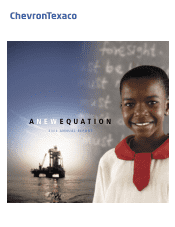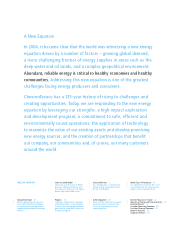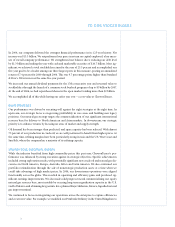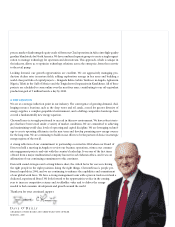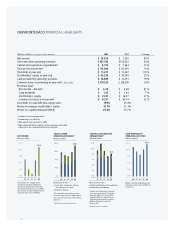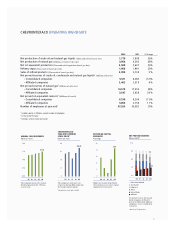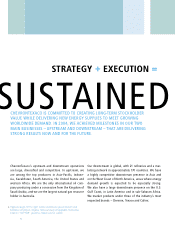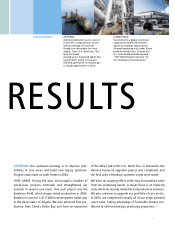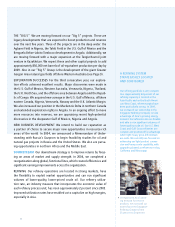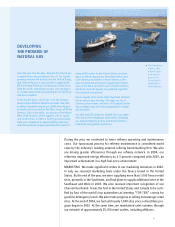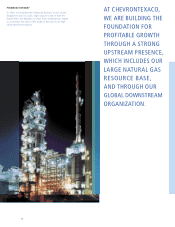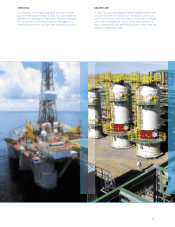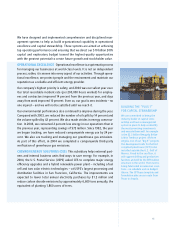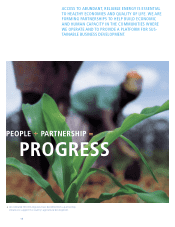Chevron 2004 Annual Report Download - page 10
Download and view the complete annual report
Please find page 10 of the 2004 Chevron annual report below. You can navigate through the pages in the report by either clicking on the pages listed below, or by using the keyword search tool below to find specific information within the annual report.
8
THE “BIG 5” We are moving forward on our “Big 5” projects. These are
legacy developments that are expected to boost production and reserves
over the next five years. Three of the projects are in the deep water: the
Agbami Field in Nigeria, the Tahiti Field in the U.S. Gulf of Mexico and the
Benguela Belize-Lobito Tomboco development in Angola. Additionally, we
are moving forward with a major expansion at the Tengizchevroil joint
venture in Kazakhstan. We expect these and other capital projects to add
approximately 850,000 net barrels of oil-equivalent production per day by
2009. Also in our “Big 5” lineup is the development of the giant Greater
Gorgon Area natural gas fields offshore Western Australia (see Page 9).
EXPLORATION SUCCESSES For the third consecutive year, our explora-
tion efforts achieved excellent results. Major discoveries were made in
the U.S. Gulf of Mexico, Western Australia, Venezuela, Nigeria, Thailand,
the U.K. North Sea, and the offshore area between Angola and the Repub-
lic of Congo. We acquired new acreage in the U.S. Gulf of Mexico, offshore
eastern Canada, Nigeria, Venezuela, Norway and the U.K. Atlantic Margin.
We also increased our position in the Mackenzie Delta in northern Canada
and extended exploration rights in Angola. In an ongoing effort to move
more resources into reserves, we are appraising recent high-potential
discoveries in the deepwater Gulf of Mexico, Nigeria and Angola.
NEW BUSINESS DEVELOPMENT We intend to build our reputation as
a partner of choice to secure major new opportunities in resource-rich
areas of the world. In 2004, we announced a Memorandum of Under-
standing with Russia’s Gazprom to begin feasibility studies for oil and
natural gas projects in Russia and the United States. We also are pursu-
ing opportunities in northern Africa and the Middle East.
Our downstream strategy is to improve returns by focus-
ing on areas of market and supply strength. In 2004, we completed a
reorganization along global, functional lines, which created efficiencies and
significant earnings improvements across the organization.
REFINING Our refinery operations are located in strong markets, have
the flexibility to exploit market opportunities and can run significant
volumes of lower-quality, lower-priced crude oil. Our refinery utiliza-
tion rate, an industry measure that incorporates the economic value of
each refinery process unit, has risen approximately 2 percent since 2003.
Improved utilization rates have enabled us to capitalize on high margins,
especially in Asia.
A REFINING SYSTEM
STRATEGICALLY LOCATED
AND CONFIGURED
Our refining portfolio is very competi-
tive. Approximately 60 percent of our
refining capacity is located in the
Asia-Pacific and on the North Ameri-
can West Coast, where margins have
been particularly strong. In 2004,
we increased our ownership in the
Singapore Refining Company to take
advantage of Asia’s growing energy
demand. Our refineries also are flexible
and able to run significant volumes of
lower-quality crude oil. Our U.S. West
Coast and Gulf Coast refineries are
complex and positioned for advantage
when light-heavy price differentials
are wide. We currently are focused on
enhancing our light product conver-
sion and heavy crude capability, with
upgrades planned at refineries in Asia,
California and Mississippi.
> In response to Asia’s grow-
ing demand for refined
products, we increased our
ownership in the Singapore
Refining Company from
33 percent to 50 percent.

